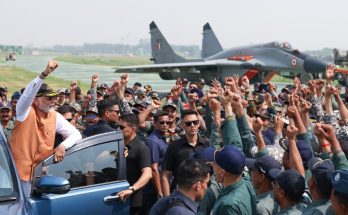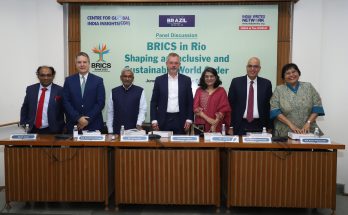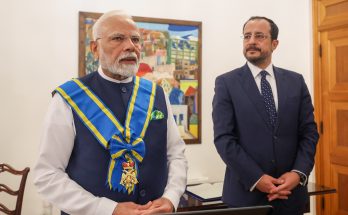By Baladas Ghosal
The year 2020 will not have any positive claim to history, but it will surely be remembered as a year that wrought death, destruction, disruption to normal day-to- day life, acute miseries to ordinary common men everywhere in the world and uncertainties for all, due to a virus called Covid-19, believed to be originating from Wuhan, China. The year will also be remembered for an unprecedented assertiveness and aggressive behaviour by Beijing under the leadership of Xi Jinping transforming himself into the mould of an Emperor, towards most of its neighbours throwing the Indo-Pacific region into a spin and uncertain geo-political shift.
Both these developments will have a profound effect on the way we look at the region in the coming days forcing us to chart out new priorities and identification of new areas of engagement and strengthening the existing areas of cooperation with ASEAN countries, says Prof. Baladas Ghosal, Former Professor and Chair in Southeast Asian Studies, Jawaharlal Nehru University.
The number of novel coronavirus cases in Southeast Asian countries rose to 1,22,9421, as per ASEAN briefing on December 4, including a little more than 30,000 fatalities and 1,028, 897 recoveries with fatality rate at 2.40%. A number of new cases and deaths were recorded in member states of the Association the past day. Indonesia and the Philippines now are the worst-hit countries in the region, the total number of infections climbed to 563,680 and 436,345 respectively, with 17,479 deaths in the former and 8509 in the latter. Indonesia saw a record 8,369 new cases and 156 deaths on 3rd; and 5803 new cases 124 deaths on 4th December. The Philippines witnessed 1995 new cases and 73 deaths on those two days, taking the total number of infections to 436,345 and 8509 deaths. Myanmar is the third worst hit country with 2829 new cases on 3rd and 4th December bringing the total to 95,018 cases and 2028 deaths. Malaysia recorded 1141 new cases on 4th taking the total to 70,236 amid 376 deaths. Singapore saw three new cases on 4th December, bringing the total to58, 242. Recoveries are quite high in the city state, and the fatalities are less than 100. The infections are quite low in other countries in Southeast Asia, with Thailand having only 4053 cases, even though it was the first country the region to have a corona case in January this year, a man having returned from Wuhan.; 151 cases in Brunei, 335 in Cambodia, 39 in Laos.

Vietnam did extremely well at the initial stage in curbing the spread of infection in the country, but in course of time may have felt complacent and relaxed the lockdown in opening up business and domestic tourism, including 551 linked with central Da Nang city since the latest outbreak began there on July 25. As of December 4, Vietnam’s Ministry of Health confirmed a total of 1,361 cases of COVID-19. However, 1,209 of the affected patients have recovered and been discharged from hospitals. Vietnam has also recorded 35 deaths due to the pandemic. The latest cases were all imported and quarantined on arrival.
A spike in coronavirus infections in Indonesia’s holiday island of Bali and Thailand’s first locally transmitted case in 100 days have dealt further blows to Southeast Asian hopes of reviving vital tourism industries. Plans to reopen Bali to foreign tourists from September have been postponed indefinitely, while Thailand’s proposal for the cautious reopening of Phuket Island has come into doubt. Epidemiologists and public health experts said the arrival of tourists in Bali not only made infection from other parts of Indonesia more likely, but underscored the country’s shortcomings in tackling the pandemic, namely a lack of testing and contract tracing. Public health experts also said another likely contributing factor was the arrival of the more infectious mutation of the virus, known as D614G.
Indonesia’s economy had its first quarterly contraction in over two decades in the second quarter — with Bali’s economy shrinking even more than the rest of the country at nearly 11 percent. Thailand, where foreign visitor spending made up over 11 percent of GDP last year, has been even harder hit by the collapse in tourism despite better managing the pandemic — also contracting the most since the Asian financial crisis in the second quarter. Thailand suspended plans for a “travel bubble” agreement with select countries in August as new daily coronavirus cases rose in parts of Asia.
Response to ASEAN countries

Responses around the region have varied. After decisive action — and missteps — in the initial months, Vietnam, Thailand, Brunei, Malaysia, and Singapore are now cautiously relaxing restrictions while working to avert a further wave. Indonesia and the Philippines saw significantly higher infection and death rates, leading to strong criticism against the Jokowi and Duterte administrations. As part of its collective and cohesive response to Covid-19, ASEAN became active in organizing a number meetings and conferences in the areas of health, economic and security areas. As far back as February, a conference of ASEAN Defence Ministers on ‘Defence Cooperation against Disease Outbreaks’ was organized to chart out an appropriate strategy to deal with the issue. So was the ASEAN Economic Ministers (AEM) meeting on 10 March 2020 for strengthening ASEAN’s Economic Resilience in Response to the Outbreak of COVID-19 and a video conference on 7 April of ASEAN Health Ministers for Enhancing Cooperation on COVID-19. To enhance cooperation on a broader scale ASEAN Plus Three (ASEAN plus China, Japan and South Korea) Health (APT) Ministers held a conference and APT Economic Ministers’ meeting on ‘Mitigating the Economic Impact of the COVID-19 Pandemic’ were held in June 2020, stressing the need for collective action to mitigate the economic impact of Covid-19 by adopting and leveraging technology-enabled measures. like “digital trade to allow businesses, especially the micro, small and medium enterprises (MSMEs) to continue operations amidst the COVID-19 outbreak”.3 The statement also laid emphasis on making the trade facilitation platforms like ASEAN Single Window more robust so as to keep the supply chain activities ongoing. To supplement these, a virtual Special APT Summit on Coronavirus Disease 2019 was held on 14 April 2020 with Prime Minister Nguyen Xuan Phuc of Vietnam in the Chair, issuing a joint statement resolving to strengthen the early warning system in the region for pandemic control, and for taking pre-emptive measures to boost market confidence in the region and to improve economic resilience. It was also agreed to establish a COVID-19 ASEAN Response Fund for public health emergencies. The ASEAN+3 Field Epidemiology Training Network also has been engaged in experience sharing of national responses and thus building capacities and preparedness on a regional level. It may be noted here that for South Asia, earlier in March, the Indian Prime Minister had proposed during the South Asian Association for Regional Cooperation (SAARC) virtual meeting for the establishment of a Covid-19 emergency fund to fight the pandemic.
The ASEAN Senior Officials’ Meeting on Health Development (ASOMHD), a core governing body responsible for the strategic management and implementation of the APHDA, through virtual meetings with ASEANN’s key dialogue partners for the next three months, activated a channel of communication to facilitate the exchange of information between its Health Division and ASEAN member countries. This channel allowed for health experts and officials from member countries to conduct a series of virtual meetings with Beginning on February 20, ASEAN health representatives held video conferences regularly with Chinese health experts to learn from China’s experience. The Special ASEAN Summit, which brought together heads of states from the 10 member countries, and the ASEAN+3 Summit, which included leaders from China, Japan, and South Korea were held virtually on April 14 and created a COVID-19 Response Fund to support preventive efforts such as procuring medical supplies and equipment for frontline response in member states. The Response Fund was to come from the ASEAN Development Fund and other co-operative partner funds. However, the details of the exact funding amount and its final implementation remain vague. With the Fund, ASEAN hoped to pool resources and redistribute them to ASEAN members, especially those with less developed public health systems. Even while attempts were made by ASEAN for working out a collective response to Covid-19, it was slow and patchy raising new questions around the organization’s relevance in dealing with a global issue like a pandemic. The numerous meetings and summits brought only a patchwork of actions. And the most important meetings, the ASEAN Summit and ASEAN+3 Summit on COVID-19 were not held until April 14, more than one month after the WHO declared COVID-19 a pandemic.
ASEAN also failed to create a Task Force on COVID-19 to lead response efforts, something it did successfully with the Task Force on Highly Pathogenic Avian Influenza during the 2008 H5N1 outbreak. It appears that President Jokowi of Indonesia had raised the idea of creating a task force with China, Japan, and South Korea, but it did not materialize due to the chaotic domestic circumstances of many member states since the Summit, and also because, it became both too late and too burdensome to establish an effective task force. According to a Vietnamese scholar, Trieu Hai Ly, “The bloc was also stymied in its pandemic efforts due to specific domestic issues among some of its member states. Examples include Cambodia’s erosion of freedoms and power-grabbing through the controversial state of emergency law, Indonesia’s tardy response, and Singapore’s upended containment success. In the shadow of these issues, combined with the visible success and failure stories of some of its high-profile members, ASEAN’s broader efforts have been rendered somewhat invisible.” The same scholar also feels that ASEAN will face significant pressure to restore confidence in its institutional vitality in the post-pandemic world. ASEAN has not been able to act swiftly in the current crisis as it encountered too many roadblocks to effectiveness, and may find similar challenges ahead.
Vaccine Plan of Southeast Asian Countries
Now with the hopes of vaccines to treat the disease rising, all ASEAN countries are rolling out their plans for it. Cambodia is expected to import vaccines from both China and Russia. China’s vaccines are still undergoing clinical trials while Russia has already commenced production. Australia has offered financial support to aid vaccine coverage in several Southeast Asia countries including Cambodia. Indonesia has commenced vaccinations with just over nine million doses being given to front line workers from last month. China’s Sinovac is in discussions with Indonesia to provide supplies, however, the Government faces difficulties with a large population of 268 million and price sensitivity at Sinovac’s estimated costs at 200,000 rupiah (US$20) a dose. Laos has been trialing the Russian Sputnik V vaccine and is also in discussions with China about acquiring supplies. The most ambitious plan is of Malaysia, which hopes to provide vaccines free of charge to its nationals, but foreigners will need to pay for the treatment, according to the Malaysian Minister of Health, Tan Sri Muhyiddin Yassin, who has signed a deal with Pfizer for 12.8 million doses. These will be administered in two stages of 6.4 million people each, with the program to commence in Q1 2021. The country aims to inoculate between 80-100% of its citizens. Myanmar is seeking assistance from the Gavi and Covax programs to acquire vaccines with the financial assistance from the Australian government. At present it aims to treat 20 percent of the ‘most at risk’ in the country with vaccines. With the constraints of finances and logistics, compounded by US sanctions, while cases are surging, Myanmar has banned the celebration of Christmas and other seasonal celebrations.

The Philippines aims to commence vaccinations from June 2021 and expects to inoculate about 25 million people (about 25 percent of its population) over the course of the year. With the cases rising, the country’s business community has, more than 30 local companies signed an agreement to purchase at least 2.6 million vaccine doses from AstraZeneca in the country’s first such deal to secure coronavirus vaccines, ten days ago. They plan to donate a large part of the doses to the government for its planned vaccination program and use the rest to inoculate their employees. Thailand is currently expecting vaccines to be delivered in mid-2021. The doses would cover 13 million people in a population of about 69 million. Thailand’s National Vaccine Institute signed a non-refundable advance market commitment contract worth 2.38 billion baht (US$79 million) with AstraZeneca to reserve the supplies. Discussions are also on-going with Oxford University in the UK to secure a vaccine that could be available in Q1 if trials are completed in time.
Vietnam’s National Institute of Hygiene and Epidemiology (NIHE), a division of Vietnam’s Ministry of Health, has signed an agreement with Medigen Vaccine, a Taipei, Taiwan-based Vaccine Company to secure the supply of 3 million to 10 million COVID-19 vaccine doses in 2021. Medigen is currently conducting Phase II studies of the vaccine, co-developed with the USA’s National Institutes of Health (NIH), in Taiwan and Vietnam with a view to a Q1 2021 rollout. Vietnam is also working on producing its own vaccine, with the Institute of Vaccines and Medical Biologicals (IVAC) in Nha Trang City, partnering with New York City-based Icahn School of Medicine and the global health non-profit organization PATH. Phase 1 trials are already underway in Vietnam, while Phases 2 & 3 will be conducted at the beginning of 2021. The institute plans to submit documents for approval to the health ministry as early as April next year and claims to be capable of producing 30 million doses a year, expecting that a national vaccine could be distributed to the general population in October 2021.
While the vaccine plan of ASEAN countries to treat the pandemic looks quite impressive, their success is still quite uncertain by a number of imponderables – logistics of the plan as well as the need for huge financial requirements and above all the efficacy of the vaccines on trial in different countries of the world.
Author Profile
- India Writes Network (www.indiawrites.org) is an emerging think tank and a media-publishing company focused on international affairs & the India Story. Centre for Global India Insights is the research arm of India Writes Network. To subscribe to India and the World, write to editor@indiawrites.org. A venture of TGII Media Private Limited, a leading media, publishing and consultancy company, IWN has carved a niche for balanced and exhaustive reporting and analysis of international affairs. Eminent personalities, politicians, diplomats, authors, strategy gurus and news-makers have contributed to India Writes Network, as also “India and the World,” a magazine focused on global affairs.
Latest entries
 India and the WorldJune 26, 2025Operation Sindoor: India Sheds Restraint, Rediscovers Utility of Force
India and the WorldJune 26, 2025Operation Sindoor: India Sheds Restraint, Rediscovers Utility of Force India and the WorldJune 23, 2025BRICS summit in Rio to focus on Global South, local currency trade
India and the WorldJune 23, 2025BRICS summit in Rio to focus on Global South, local currency trade Africa InsightsJune 11, 2025New Opportunities in India-Japan Cooperation in Africa
Africa InsightsJune 11, 2025New Opportunities in India-Japan Cooperation in Africa India and the WorldMay 23, 2025Post-Operation Sindoor, India reminds Turkey, China of concerns and sensitivities
India and the WorldMay 23, 2025Post-Operation Sindoor, India reminds Turkey, China of concerns and sensitivities







